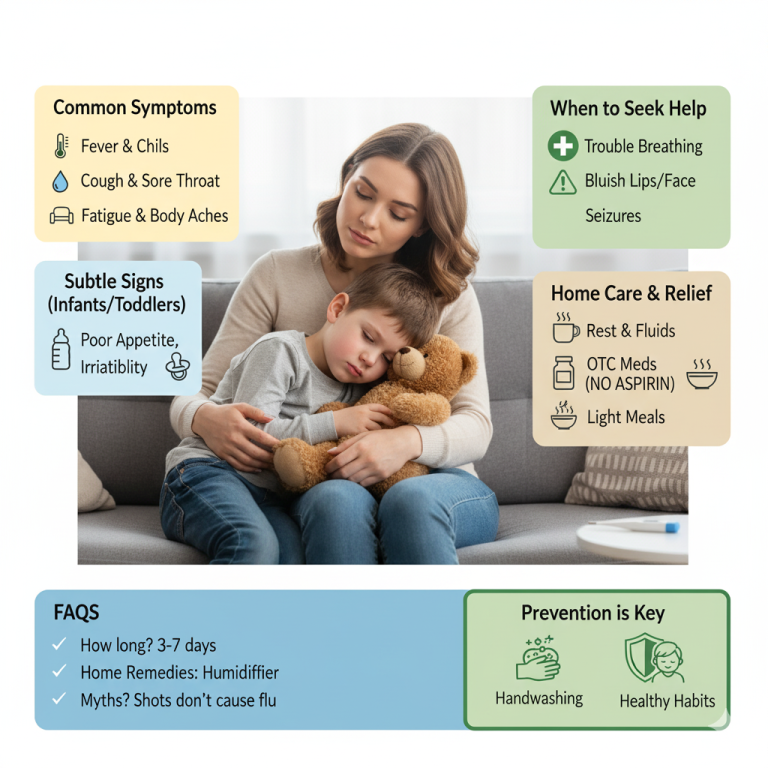
When your child falls ill, it can be hard to tell if it’s just a common cold or something more serious, like the flu. Influenza, or flu, is a contagious respiratory illness that can be severe in children. Early detection and proper care are crucial to keep your child safe. Parents, caregivers, and home health aides play a vital role in recognizing early signs and seeking timely medical attention.
What is Influenza (Flu)?
The flu is caused by a virus that infects the nose, throat, and lungs. It spreads through tiny droplets released when an infected person coughs or sneezes. Children often transmit the virus to each other in daycares, schools, and playgrounds.
Flu vs. Cold vs. Other Infections:
- Flu: Sudden onset, high fever, body aches, fatigue.
- Cold: Gradual onset, milder symptoms like runny nose and mild sore throat.
- Other infections (e.g., stomach flu): Primarily affects the digestive system with vomiting and diarrhea.
Common Flu Symptoms in Children
Flu symptoms in children can differ from adults. Watch for:
- Fever and chills: High fever (100°F / 37.8°C or higher) and shivering.
- Cough, sore throat, runny/stuffy nose: Often dry and persistent.
- Fatigue, body aches, headaches: Children may appear lethargic and complain of pain.
- Vomiting, diarrhea, irritability: More common in infants and toddlers.
- Subtle signs in young children: Poor appetite, unusual sleepiness, or crankiness.
Age Specific Symptoms
- Infants: Feeding difficulties, irritability, lethargy, high fever.
- Toddlers: Sudden mood changes, vomiting, high fever.
- School-age children: Classic flu symptoms similar to adults, including fever, cough, and fatigue.
Children at High Risk & Warning Signs
Some children are more likely to develop severe flu:
- Under 5 years, especially under 2
- Chronic health conditions like asthma, diabetes, or heart problems
Emergency warning signs – seek immediate medical attention if your child has:
- Trouble breathing or shortness of breath
- Bluish lips or face
- Signs of dehydration (less urination, no tears when crying)
- Persistent high fever that doesn’t respond to medication
- Confusion or unresponsiveness
- Seizures

Flu Treatment for Kids
Home Care & Symptom Relief
- Rest and hydration: Plenty of sleep and fluids like water, juice, or soup.
- Over-the-counter medications: Acetaminophen or ibuprofen for fever and pain (never give aspirin to children).
- Comfort care: Use humidifiers, saline drops for stuffy noses, and light, easy-to-digest meals.
Medical Treatment
- Antiviral medications: Prescribed in some cases to shorten illness duration, most effective within 48 hours of onset.
- Hospitalization: Required in severe cases, especially for young or high-risk children.
Monitoring & Documentation (Home Health Aide Angle)
- Track temperature, fluid intake, and symptoms daily.
- Keep a log to share with your pediatrician.
- Watch for any worsening signs and report promptly.
Prevention & Protective Measures
- Annual flu vaccination: Recommended by the CDC for all children 6 months and older.
- Hand hygiene: Frequent handwashing reduces infection risk.
- Cough etiquette: Cover mouth and nose when coughing or sneezing.
- Healthy habits: Adequate sleep, nutritious diet, and regular exercise.
- Environmental controls: Use humidifiers, ventilate rooms, and disinfect surfaces and toys.
Role of Parents, Caregivers & Home Health Aides
- Monitor your child’s health and report changes to healthcare providers.
- Assist with medications, meals, hydration, and comfort care.
- Reduce exposure risk for siblings and other family members.
- Educate children about hygiene and prevention measures.
FAQs / Common Concerns
How long does the flu last in children?
Most symptoms last 3–7 days; cough and fatigue can persist for up to two weeks.
When can kids go back to school/daycare?
Only after being fever-free for at least 24 hours without fever-reducing medication.
Flu Relief & Facts
Home remedies:
- Honey for sore throat (do not give to children under 1 year)
- Steaming or saline gargles can provide relief
Myths about the flu:
- Flu shots cannot give children the flu.
- Antibiotics do not treat flu because it is a viral infection.
Conclusion
Recognizing and managing flu in children can be challenging. Understanding symptoms, treatment, and prevention, and seeking timely medical care are essential. As a caregiver, your knowledge, monitoring, and quick action can make a significant difference in your child’s health.
